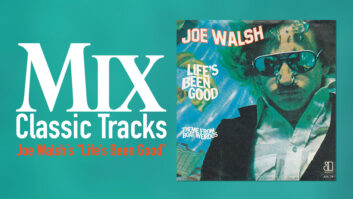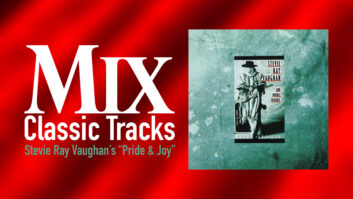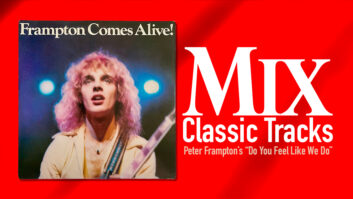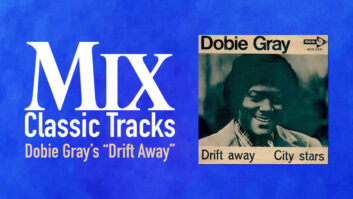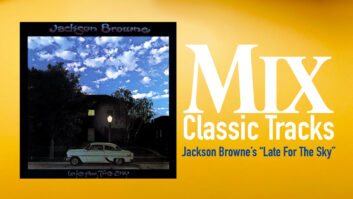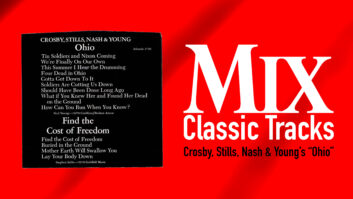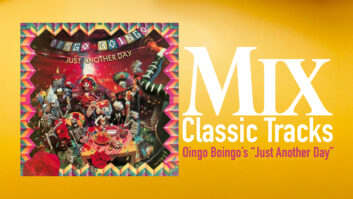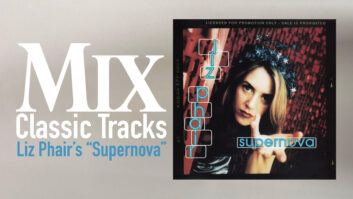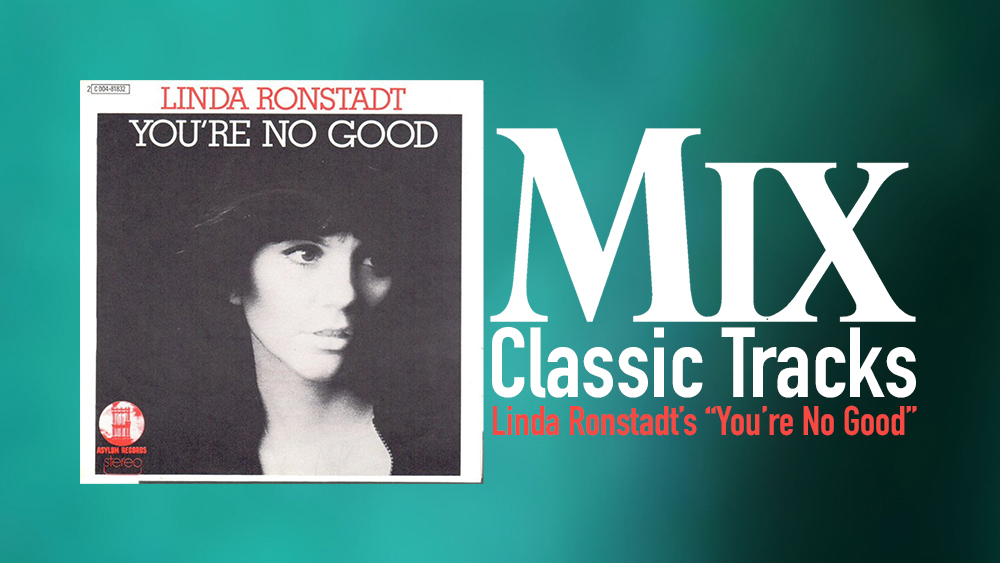
Linda Ronstadt had her first hit single, “Different Drum,” in 1967 as a member of The Stone Poneys, then had a series of solo albums in the early 1970s following the group’s breakup. But it wasn’t until November 1974, 40 years ago this month, with the release of Heart Like a Wheel, produced by Peter Asher, and its lead-off single, “You’re No Good,” that the singer landed squarely at the top of the charts, a place she would find herself many times throughout the rest of her career.
After years as half of the popular pop-folk duo Peter and Gordon, Asher had at the time absorbed enough experience from EMI staff producers Norman Newell and John Burgess to begin taking on full production himself. “I loved the idea of it, and I loved the technology of it,” Asher says. “Once I figured out you could hire musicians better than yourself and tell them what to do, I thought it was brilliant.”
In 1968, Paul McCartney asked Asher to begin producing artists for The Beatles’ fledgling Apple label, eventually asking him to become head of A&R. He produced James Taylor’s eponymous album for Apple, and then, in spring 1969, he left for the U.S. to continue managing and producing him.
Asher first encountered Ronstadt around 1970-71 at New York’s The Bitter End. “Somebody told me, ‘You have to go and see this girl, she’s one of the best things you’ll ever hear in your life,’” he recalls. “’And she wears these really short shorts, and sings barefoot, and is ridiculously hot.’ And it was all true.”
The Setup
After both Ronstadt’s and Asher’s moves to Los Angeles not long after, at the suggestion of musician friend John Boylan, she asked Asher to manage her. During the production of her 1973 album, Don’t Cry Now, at Clover Recorders in Hollywood, Asher signed up and helped complete the album. “I was working with John Boylan, and then J.D. Souther, and I just felt like I wasn’t getting anywhere with it,” the singer recalls. Adds Asher, “It had been drifting for a bit, so I tried to finish and tidy that up,” producing several tracks himself.
Ronstadt was well familiar with Betty Everett’s 1963 hit R&B version of Clint Ballard’s “You’re No Good” when bassist Kenny Edwards suggested it for inclusion in her band’s set for an upcoming Neil Young tour during the first three months of 1973. Edwards, an original member of the Stone Poneys, had rejoined Ronstadt’s band after spending several years in India. “We would be jamming during rehearsal, and Kenny said, ‘Why don’t we do this, it would be fun?’” Ronstadt recalls. “I’m a ballad singer, and in a lot of the venues we were playing, the air conditioning was louder than we were. So we had to have a couple of uptempo songs to open and close with. And that was a really good closer.”
The arrangement [which can be seen on a “Midnight Special” clip from December 1973] was indeed an R&B style, based around a Wurlitzer part played by John Boylan, accompanied by guitarist Andrew Gold. Ronstadt had met the talented Gold a few years earlier, when the Poneys had played at his high school in Southern California, and became friends, with Gold joining her band in late 1973. For “You’re No Good,” at this point, Gold played a riff similar to the opening section heard on the finished record, though he then broke into an improvised lead.
The band continued playing the song with that arrangement, though it somehow managed to evade recording for Don’t Cry Now. [Curiously, AFM records show a session taking place for the song at Clover on May 27, 1973, featuring a talented lineup of top session players: guitarist Larry Carlton, bassist Chuck Rainey, session drummer Ed Greene, keyboardist Michael Omartian, The Pastora Brothers on percussion and others. However, neither Ronstadt, Asher, Boylan, Souther nor musicians Rainey and Carlton recall any such session, making it unlikely that it ever actually took place.]
When the time came to record a follow-up album the next summer, Ronstadt and Asher tossed around ideas for a producer, and, as Asher notes, “It ended up being me.”
Asher then picked The Sound Factory for the studio dates, mainly for the opportunity to record with legendary producer/engineer Dave Hassinger. Known for his classic recordings with The Rolling Stones and Sam Cooke, among others, Hassinger had been a staff engineer at RCA Hollywood before being hired by Mo Ostin to join Warner/Reprise as a producer, helming several albums for the Grateful Dead and other artists. He left the label in 1969 upon purchasing Moonglow Recording Studios, which he renamed The Sound Factory, at 6357 Selma Avenue in Hollywood.
After Ronstadt and Asher arrived in early June to begin the project, they quickly found themselves without Hassinger. “He worked with them for about three or four days, and then called me up on the phone and said, ‘I’m not coming down today. Could you take over?’” recalls engineer Val Garay, then an assistant who had introduced himself to Hassinger three years previously and worked his way up. Notes Asher, “When I booked The Sound Factory, it was with the intent of working with Dave Hassinger. But he kept not turning up, and this assistant bloke was showing up instead. And after a few sessions, I told the studio, ‘Actually, this assistant bloke is extremely good. Tell Dave to stay home.’” [Laughs.]
The studio had a single, small live room, with what all describe as “an incredible sound.” The control room featured a 32-channel, 24-bus API console, one of the first API desks on the West Coast. Garay recalls, “When I first started working there, Dave had a Frank De Medio console, which was custom-made with API components. He sold that to Seals & Crofts, after we’d done Summer Breeze, Diamond Girl and Hummingbird on it. That’s how Dave got into API.” Garay recorded to a 3M M79 tape machine onto Agfa PEM 468 tape stock. “I loved that tape.”
The Sessions
Song choices for what would become Heart Like a Wheel were split between Ronstadt and her producer, the singer tending to lean more toward country music, or, as she would sometimes refer to it, “granola rock.” “I was a club act,” she points out. “I was playing the Palomino Club, playing country songs.”
The album—with the exception of its two singles—is decidedly country, and, true to form for Asher in the day, not overly complex. “I’ve made complex records,” he says. “But I do like records where you can hear what’s going on, tonally speaking. I don’t like muddle. You’re only complex for a good reason. I was later accused of being too clean and too precise. But that did not hurt me. I believe in capturing whatever live magic there is and whatever happens at the time in the studio. I don’t miss anything.”
A month into recording, both Ronstadt and Asher decided to include “You’re No Good” on the album. “I thought it was a good song to layer in amongst the ballads,” the singer notes. Says Asher, “It was an odd coincidence. She’d been doing the song already, and it was always a favorite song of mine—though not the Betty Everett version. The version I fell in love with in England was The Swinging Blue Jeans cover of it. Though I did go back and listen to the originals, just out of curiosity.”
Once the decision was made to record the song, it was then a matter of finding the right arrangement. “We had been doing it one way live, but when we got into the studio, we decided to change it—we were tired of it,” Ronstadt says. “We tried two or three different types of rhythm sections before we found the one we liked,” adds Asher.
The first was recorded on July 1 with a decidedly mixed rhythm section, with both R&B and country players: Gold on guitar, accompanied by Bob Warford, a “bendy” blues guitar lick player from Ronstadt’s band. Bass was handled by R&B/rock session player Paul Stallworth, who brought in Earth Wind & Fire’s Fred White on drums. “I was always trying to put together different versions of R&B and country,” Ronstadt explains. “Sometimes it worked, and sometimes it was just really awful!”
“They were trying to do an R&B version of the song, which was actually closer to the way we did it live than to the released version,” recalls Warford, who toured with Ronstadt from mid-1972 until just about a month after this recording. “We played it at a faster tempo live, which we did on that recording.” There was also no 16-bar guitar break for Gold, as would appear on the final version a few days later.
The rhythm was straight rhythm and blues, says Stallworth, with the band playing live from chord charts. But the combination wasn’t quite what Ronstadt had in mind. “It was just the wrong groove for me,” she recalls. “I don’t think I knew how to phrase around them—certainly no fault of theirs. They were fantastic.”
Notes Stallworth, “She was so sweet. She said, ‘Aw, you guys, I love that track, but I don’t know if I can sing to that.’ She wasn’t singing live with us, and I’m sure if she were singing it the way she sings it, I know I would have played it differently.”
Yet another version may have been attempted, but for the final recording, made on July 5, Asher decided not to do a completely live recording, as on the previous attempts. “Those seemed to just get muddled,” he recalls. “So I suggested that we try building a track, which is much more common now than it was then.”
The arrangement approach, mostly developed by Asher and Gold, got its start with a guitar riff played by touring band guitarist Eddie Black (heard essentially during the first verse and string buildup only, and nowhere else on the album). “Eddie was just fooling around on his Les Paul, and came up with that riff, and then Kenny joined in on bass,” Ronstadt says. “Between them, they made that foundation.”
They were joined by the drummer Gold. “Peter and I both thought he was really good,” she recalls. “He could play everything, and well.”
At the time, Gold told future Ronstadt drummer Michael Botts in 2001, the band was having trouble finding a decent drummer, “So I ended up playing. I borrowed kind of a cheap, candy cane kit from a guy named Gene Garfin, and I played sort of a pseudo-Motown thing.” Says Asher, “He could play basic, simple licks—but very good. He did Ringo drumming.”
Garay miked him with a Sound Factory favorite, a number of Telefunken 251s, both for toms and overheads. “Hassinger used to do big orchestras, and nobody ever used those mics for anything other than orchestral recording,” Garay notes. “I always thought they were a great-sounding tube mic, so I started putting them on drums.” Particularly for Gold. “I loved the way they made his toms sound, and I loved the fills he did. I used to call them ‘the pachyderms’—he’d go ‘pachyderm-pachyderm,’” which Garay would mix into mono for stronger effect.
Asher wanted to track just drums alone and build from there, but eventually recorded Gold, Edwards and Black together as a rhythm section. It was decided, at that point, to leave a 16-bar break in the middle for something, to be figured out later.
After the morning’s work of rhythm tracking, it was decided to add two tracks of Gold playing a Wurlitzer electric piano. “He’s essentially playing the part I played live, but far better than I could have played it,” Boylan notes.
“I did two tracks, one octave higher than the other,” Gold describes. Notes Garay, “Andrew did a high part and a low part on everything! He loved to do that.” The core of the song was then complete. “That’s really the essence of the track—the Wurlitzer, bass and drums,” Asher says. “All the guitars are just decoration.”
‘Then we said, ‘Okay, now we gotta address this issue of the whole middle section,” Gold recalled. While Ronstadt was often fairly hands-on and present for most tracking, for this section, she says, “Andrew and Peter cooked all that up themselves. Peter’s a very good editor. And by that, I mean, Andrew would have an idea a minute, and Peter’s really good at sorting out stuff. A producer’s job is a lot of things, but one of them is to just choose the tastiest bits that grab you by the collar. And Peter did exactly that on that track.” With, adds Asher, “Sound design by Val.”
Gold began experimenting, creating three sections to the middle break (the middle one being considered the true “solo”), playing on a black 1962 Fender Stratocaster Boylan had picked up for Ronstadt at a pawn shop during the Neil Young tour for Ed Black’s use. “It had a rosewood fingerboard,” he says. “And the minute Andrew put his hands on it, he fell in love with it.” Adds Ronstadt, “I think he wound up with that guitar. I don’t think he ever… loaned it back.”
Gold worked out three very different, and precisely played, parts for the three sections. “Andrew was great at guitar playing, but he wasn’t a virtuoso,” Garay explains. “As he came up with ideas, he had to work out how to play them.” Notes Asher, “The cool thing about Andrew was, he played really precise parts. He could double parts and add guitar harmonies, because he knew exactly what he was going to play. I remember singing him some of the parts, and also him inventing parts, and he had it down.”
The guitars were recorded through a unique chain developed by Garay, Asher and Gold. Before hitting the console, the signal went through a small MXR graphic EQ, a favorite of Asher’s. “It’s just a way of adding high end to the direct signal before it went through anything,” he explains. “It made it crispy, and gave it a synthetic texture. If you added it later, it would just create too much hiss.” Garay then passed the signal through two UREI 1176 limiters, compressing in series. “I could come out of one with the input cranked, into the next one with the input cranked,” he explains. “That signal was then fed through a Kepex noise gate, set with the fastest possible release time. So the minute Andrew touched the strings, the sound exploded through the gate.”
Another device used in the chain was a unique—and rare—delay unit known as an EMT Sound Retardation System. Originally designed for concert hall use, the EMT contained a flat disc of recording material, with three sets of recording and playback heads, staggered to allow the user to select either 25, 125 or 250 ms delays—or even all three, if desired.
John Phillips had brought this back from England in 1971, and we never really used it,” Garay recalls. “Dave just let it sit there, and then, out of my own curiosity, I started fiddling with it.” The trouble was that by the time Asher and team were ready to use it, they discovered it was broken, the disc having become warped. “As the disc rotated inside, it gave the signal a warbly sound.”
Noted Gold, “We heard it, and went, ‘Oooooh, can we have that? We like that. It’s broken. That’s great!’” The EMT’s effect can be heard on the first section of the lead break, as well as on the guitar arpeggios following the string buildup later in the song (the latter played on a Telecaster).
For additional effect, Gold doubled—sometimes tripled—his parts, with Garay recording each with the tape speed varied just slightly between takes, in combination with Gold’s tuning the guitar slightly sharp and flat in subsequent takes, giving the track group a unique jangly sound when mixed together. The method was especially successful, again, thanks to Gold’s precise, accurate replaying of the parts, with the third section of the guitar break featuring doubled leads and harmonies.
The result of the team’s handiwork was decidedly Beatles-esque. “As was my wont,” Gold joked. After working overnight on the lead break one evening in a 15-hour marathon session, and rather pleased with their work, they played it for Ronstadt, who, at first, wasn’t pleased. “Albert Brooks was in the studio with us,” she recalls, “and when they played that solo, Albert said, ‘That sounds pretty good. But I’m just wondering why, in the middle of the song, does it suddenly turn into a Beatles record?’ Peter was not happy about that. And Andrew was completely busted, because, of course, that was exactly what his intention was.”
Ronstadt requested that Kenny Edwards come in and play a blues take on the section, which he did. The rest of them, meanwhile, were quite glum. “I had gone home to sleep,” Gold said. “When I came in at 3 p.m., the others said, ‘Good you were late, you didn’t have to live through that!’” She eventually came around, after taking a break with Brooks and having a second listen. “I was kind of on the fence about it. I wasn’t sure I wanted it to sound like a Beatles record myself. But, frankly, it was really good!”
Ronstadt had equal reservations about her own lead vocal, recorded, perhaps, Asher says, the same evening the Wurlitzer part had been added, completing the basic track. “I normally would do one as soon as we had any kind of structure,” he notes, though Ronstadt recalls recording it live during tracking, as she would also sometimes do. “It’s a live vocal, and it’s a terrible vocal,” she says, judging herself far more harshly than most listeners would upon hearing her strong, stirring performance. “I was so tired. It was about getting the phrasing—I just felt like I had rushed the timing, and didn’t just lay back in the groove. That was before I’d really learned about overdubbing and comping,” a skill she and Asher would master not long after.
The vocal was recorded using a Neumann U 67 tube mic, a favorite of Ronstadt’s and Garay’s, and processed with a Lang PEQ 2 equalizer, set, curiously, to boost 20k. Garay had noticed at that the time that increasing the level at that frequency on a track with a lot of sibilance actually lowered the effect of the sibilance, a trick he found useful with vocal recording.
Ronstadt’s skill and highly tuned ear was something Garay was always conscious of. “She can tell even the slightest differences in equipment, tape, mics or limiter settings,” he says. “Her ear is incredibly discerning.”
Strings were added just prior to mixing, in late August, by engineer Peter Swettenham at AIR London studios, from an arrangement by Gregory Rose, a friend of Asher’s younger sister, Clare. “I wanted someone who wasn’t going to make it a pop arrangement, so I brought in a classical guy,” the producer recalls. It ends with a strong, long held note, which Asher conceived, executed by Garay with a slow riding of the level on the string faders during the final mix.
The Mix
When the song was being mixed, a curious thing happened. As the evening’s session began, Garay inadvertently wiped the first note of Gold’s first guitar phrase in the main guitar break. “His face was ashen, when he realized it,” his producer recalls. Notes Ronstadt, “Poor Val, he was just exhausted. And Peter realized that.”
The skillful repair was made using a technique today’s engineers, working in Pro Tools, never have to master: flying in. Garay copied the same guitar phrase, which Gold had played again eight bars later, onto a 2-track tape, which would then be recorded in place of the first/clipped version of the guitar phrase, as a punch-in. He then cut the multitrack precisely at the correct punch-out point, and temporarily spliced in paper leader tape, so that a “miss” on the punch-out wouldn’t damage any of the following phrase. The two machines were then synced to begin playback and recording of the replacement phrase at precisely the right spot, with the punch-out handled simply by the presence of the paper leader tape. The master was then reassembled and then the mix was completed. Says Garay, “Today, that’s handled with a simple ‘Undo’ or ‘Cut and Paste.’”
Upon its release in November of that year, the song was an immediate smash. “The first time I heard it on the radio, I said, ‘That sucker’s a hit.’ I just knew it,” Ronstadt recalls. “It’s really a well-constructed record. I have to give Peter and Andrew credit.” The track also put Andrew Gold on the map. “I was driving along in my little Toyota with bashed windows and dented fenders and heard it on the radio,” he recalled. “The disc jockey said, ‘I’ve gotta find out who is this guitar player on this thing.’ He shuffled some papers and went, ‘It’s this guy, Andrew Gold.’ He mentioned my name, and I just died. I had to pull off to the side of the road. It was great.”
